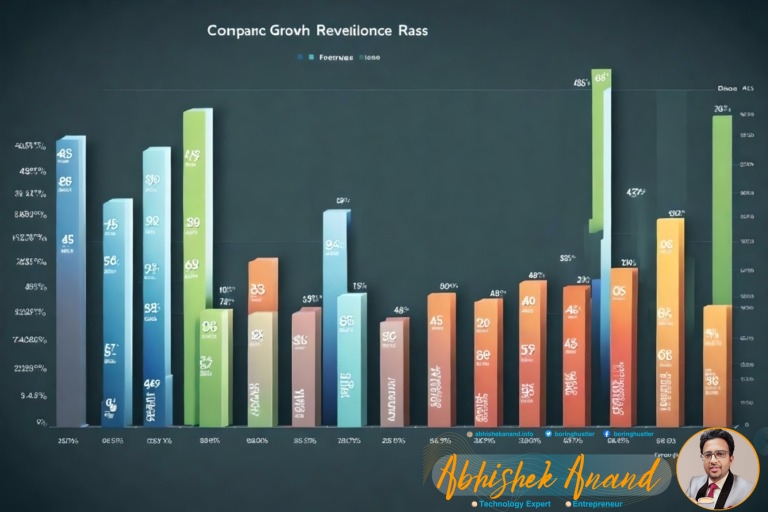Effective financial management is the backbone of every business and SaaS companies are no exception. As more businesses turn to subscription-based models, it’s essential for SaaS entrepreneurs to understand and monitor their financial performance against industry benchmarks. By doing so, they can determine whether their company is on track or if there are areas that need improvement.
SaaS financial benchmarks provide a framework for evaluating the health of a business and comparing it with industry peers. These benchmarks include metrics such as Customer Acquisition Cost (CAC), Lifetime Value (LTV), Gross Margin, Monthly Recurring Revenue (MRR), Average Revenue Per User (ARPU), Quick Ratio, Debt to Equity Ratio, Return on Investment (ROI) among others. In this article, we will examine each benchmark in detail and explore how they help SaaS companies measure their performance against industry standards.
Importance of Understanding SaaS Financial Benchmarks
The comprehension of SaaS financial benchmarks is crucial for businesses seeking to evaluate their financial performance and compare it with other industry players. Benchmarking against competitors allows companies to identify areas where they are falling behind and adopt strategies to improve their overall financial health. Without a clear understanding of these benchmarks, businesses risk making decisions that could lead to poor performance or even failure.
However, it is important for businesses not to solely rely on benchmarking when evaluating their financial performance. There are common mistakes that should be avoided when interpreting financial benchmarks, such as failing to consider the unique circumstances of one’s business or relying too heavily on averages that may not accurately reflect the company’s situation. For example, simply comparing customer acquisition costs without considering the lifetime value of customers could result in misguided decisions.
Therefore, while understanding SaaS financial benchmarks is essential for success in the industry, it is equally important for businesses to approach benchmarking with caution and a critical eye towards its limitations. The subsequent section will delve into one key aspect of SaaS financial benchmarks – customer acquisition cost (CAC) – which highlights the importance of taking a more nuanced approach when interpreting these metrics.

Customer Acquisition Cost (CAC)
On average, companies in the software industry spend a significant amount of money to acquire each new customer, which can be likened to a financial sacrifice made in order to reap future rewards. This cost is known as the Customer Acquisition Cost (CAC), and it represents the total expenses incurred by a company when acquiring new customers. CAC is an important metric for SaaS companies because it determines how much they are willing to spend on marketing and sales efforts.
CAC optimization is crucial for SaaS businesses as it directly affects their profitability. Reducing CAC involves implementing strategies such as improving lead generation tactics, optimizing customer conversion rates, and reducing churn rates. Successful CAC reduction strategies enable companies to allocate more resources towards other areas of their business, such as product development or customer support.
Understanding and monitoring CAC is essential for SaaS businesses that want to remain competitive and profitable in today’s market. By continually analyzing this metric, companies can identify areas where they can improve their marketing and sales processes, reduce costs associated with acquiring new customers, and ultimately increase their bottom line. With an optimized CAC strategy in place, SaaS businesses can shift their focus towards maximizing lifetime value (LTV) for each customer they acquire.
Lifetime Value (LTV)
The concept of Lifetime Value (LTV) refers to the estimated revenue that a customer is expected to generate for a business over their entire lifespan as their client. Calculating LTV is crucial in determining the overall profitability of a company’s customer base and understanding how much should be invested in acquiring new customers. Industry benchmarks for LTV can help businesses assess whether they are performing well relative to other companies in their sector, and identify areas where improvement may be needed to optimize long-term revenue potential.
Definition of LTV
Calculating customer lifetime value (LTV) is a crucial metric in evaluating the financial health and sustainability of a SaaS business. It represents the total revenue that a customer is expected to generate for the company during their entire relationship with the brand. This metric takes into account various factors such as customer acquisition cost, subscription pricing, churn rate, and retention period.
The importance of LTV in SaaS business strategy cannot be overemphasized. A high LTV indicates that customers are loyal to the brand, generating consistent revenue streams over an extended period. By calculating LTV for different customer segments, businesses can tailor their marketing strategies and product offerings to maximize profitability. In contrast, a low LTV signifies issues with retention or monetization strategies that need addressing before long-term sustainability can be achieved. With this understanding of what LTV entails and its significance in determining SaaS business success, it becomes necessary to learn how to calculate it effectively.
How to Calculate LTV
To effectively determine the expected revenue a customer will generate for a company, one must learn how to calculate customer lifetime value (LTV). LTV is a metric that measures the total amount of money that a customer will spend throughout their entire relationship with a business. Calculating LTV involves several factors such as the average order value, purchase frequency rate, and customer retention rate.
Calculating LTV: Tips and Tricks include using historical data to predict future behavior of customers, segmenting customers based on demographics or buying behavior, and adjusting for acquisition costs. It’s important to note that while high LTV is desirable for any business, it must be balanced with Customer Acquisition Cost (CAC). A high CAC can offset any benefits from having high LTV. Therefore, finding the right balance between these two metrics is crucial for long-term success in any industry.
Industry benchmarks for LTV can provide valuable insights into how your business compares with competitors in terms of revenue generated per customer. To understand more about these benchmarks and their significance in measuring your saas financial performance, let’s delve deeper into this topic in the subsequent section.
Industry Benchmarks for LTV
Industry benchmarks serve as a valuable point of reference for companies seeking to gain insights into the expected LTV of their customers and how it relates to their overall financial performance. By comparing their own LTV against industry standards, businesses can determine whether they are performing above or below average in terms of customer retention and revenue generation. This information can then be used to identify areas where improvements can be made, such as implementing better retention strategies or improving customer service.
Calculating LTV is crucial for any business that wants to remain competitive in today’s market. To ensure accuracy, companies should follow best practices when determining their LTV, including analyzing historical customer data and using segmentation techniques to differentiate high-value customers from lower ones. Improving LTV retention strategies is also vital since it enables businesses to maximize the value of each customer over time. By understanding industry benchmarks for LTV and implementing a robust retention strategy, companies can increase revenue while reducing churn rates, ultimately leading to greater profitability and long-term success.
Moving on to the next section about gross margin, it is essential for businesses to understand this metric in order to make informed decisions regarding pricing strategies and cost management.

Gross Margin
Remarkably, gross margin is one of the most vital metrics in determining a SaaS company’s financial health, as it reflects the company’s operational efficiency and profitability. Understanding Gross Margin: The Key to SaaS Profitability requires an understanding of how much revenue is left after deducting direct costs such as hosting, customer support, and software development. Essentially, it measures how much money the business makes from its core operations.
Gross Margin vs. Net Margin in SaaS Business is a critical distinction. While gross margin only analyzes the cost directly associated with producing goods or services sold by the business before accounting for overheads like marketing expenses and salaries paid to staff who are not involved in production, net margin factors in all other costs that are essential to running a business. In other words, net profit accounts for indirect costs such as rent expense and executive salaries.
Gross Margin plays a significant role in evaluating the financial health of any SaaS company. It provides insights into how efficient an organization is at generating profits from its core operations while ignoring any indirect costs that may be incurred elsewhere within the organization. This metric can help businesses identify areas where they need to improve operational efficiency or reduce costs without compromising their overall profitability. Moving forward we will discuss Monthly Recurring Revenue (MRR) which ties closely into Gross Margin analysis by measuring recurring revenue generated by customers on a monthly basis rather than looking at individual transactions’ gross margins themselves.
Monthly Recurring Revenue (MRR)
Moving on from gross margin, we turn our attention to another critical financial metric for SaaS businesses – Monthly Recurring Revenue (MRR). MRR refers to the total monthly revenue generated by a business through its recurring subscriptions or contracts with customers. Calculating MRR growth is essential for measuring a company’s overall performance and identifying trends in customer acquisition and retention.
MRR churn analysis is an integral part of calculating MRR growth. It involves tracking the number of customers who cancel their subscriptions or contracts each month, as well as any downgrades or upgrades in service levels that affect revenue. By comparing the MRR churn rate with new sales and upgrades, companies can determine whether they are growing or losing ground in terms of monthly recurring revenue.
For SaaS companies seeking sustainable growth, it’s crucial to focus on not just acquiring new customers but also retaining them. A high churn rate can significantly impact MRR growth and reduce profitability over time. In the next section, we’ll explore how understanding churn rate can help companies develop better strategies for reducing customer attrition and improving long-term profitability.
Churn Rate
Understanding the churn rate is critical for SaaS companies to sustain growth and profitability, as it provides insight into customer attrition and enables the development of effective retention strategies. Churn rate refers to the percentage of customers who cancel their subscriptions within a given period. For SaaS businesses, high churn rates can be detrimental to long-term success, as it indicates that customers are not finding value in the product or service.
To reduce churn rates, SaaS businesses must analyze churn rate trends over time and identify potential causes of cancellation. Four strategies to reduce churn rates include improving onboarding processes, providing excellent customer support, offering flexible pricing plans, and continuously enhancing the product or service based on customer feedback. By implementing these strategies effectively, businesses can increase customer satisfaction and loyalty while reducing overall churn rates.
Analyzing churn rate trends over time is crucial for understanding how well retention strategies are working. By tracking month-over-month or year-over-year changes in churn rates, businesses can identify areas where improvements need to be made or where current retention efforts are successful. This data-driven approach allows for targeted adjustments to retention strategies and ultimately leads to increased customer lifetime value (CLV) and revenue growth.
As SaaS companies strive for sustainable growth and profitability, analyzing metrics such as MRR and churn rate is essential. The next step in evaluating financial performance involves examining Annual Contract Value (ACV), which measures revenue generated from annual contracts with customers.
Annual Contract Value (ACV)
One way to measure the revenue generated from annual contracts with customers is through Annual Contract Value (ACV), which can be compared to a ruler measuring the length of a piece of wood. ACV is a metric that measures the total value of all contracted services for a given year, including any upsells or cross-sells. It is an essential financial benchmark for SaaS businesses looking to track their growth and performance.
ACV growth strategies are crucial for SaaS businesses since they help determine how much revenue will be generated from existing customers in the coming year. One strategy is to focus on customer retention by providing excellent service and support, leading to higher contract renewals and upsells. Another strategy is to target high-value customers who are more likely to purchase additional products or services, increasing their overall ACV.
ACV versus Monthly Recurring Revenue (MRR) has always been a debate among SaaS companies when it comes down to determining which metric provides better insight into business performance. While both metrics have their advantages, ACV offers more accurate forecasting since it takes into account all contracted services for the entire year rather than just monthly revenue streams. However, MRR provides better insights into short-term business operations and cash flow management.
Moving forward, it’s essential for SaaS companies to understand the significance of ACV in terms of tracking growth and devising new strategies for increased revenues. The next subtopic we will discuss is burn rate and how it impacts SaaS company finances.

Burn Rate
The concept of Burn Rate refers to the rate at which a company is using its cash reserves to finance its operations. It is an important financial metric that can help businesses understand their sustainability and growth potential. Calculating Burn Rate involves determining the amount of money a company is spending each month, subtracting it from their current cash balance, and dividing by the number of months until they run out of cash. Industry benchmarks for Burn Rate vary depending on the sector, business model, and stage of development, but understanding these benchmarks can provide valuable insights into a company’s financial health.
Definition of Burn Rate
The burn rate refers to the pace at which a company consumes its financial resources over a specified period of time, usually monthly or quarterly. It is an essential metric in measuring a firm’s sustainability and financial health. The calculation methods for burn rate vary depending on the business type, stage, and industry. For instance, start-ups are more likely to have a higher burn rate as they invest heavily in product research and development compared to established firms that seek to maintain their operations.
The impact of burn rate on funding cannot be overstated. A high burn rate may attract investors as it indicates that the business is willing to take risks to achieve growth potential. However, it may also signal trouble if the company fails to generate revenue or attain profitability within an acceptable timeframe. In contrast, a low burn rate shows investors that the business has strong cost management skills and can operate sustainably with minimal capital infusion. Understanding how to calculate burn rate is crucial for businesses looking to secure funding or streamline their operations without risking insolvency.
How to Calculate Burn Rate
To accurately gauge a company’s financial health and sustainability, it is crucial to understand the method of calculating burn rate. Calculating Burn Rate: Tips and Tricks involve determining the total amount of money a company spends each month to cover its expenses. This includes everything from salaries for employees to rent for office space, utilities, equipment costs, marketing expenses, etc. To calculate burn rate, simply subtract the total monthly expenses from the total monthly revenue generated by the business.
Factors Affecting Burn Rate Analysis include several variables that can significantly impact a company’s burn rate calculation. These include changes in revenue streams or pricing models, shifts in consumer demand or market conditions, unexpected expenses (e.g., lawsuits), or fluctuations in employee headcount. By staying on top of these factors and regularly recalculating burn rates accordingly, companies can gain a better understanding of their financial position over time. With an accurate picture of their current cash flow situation, they can make more informed decisions about future investments and growth strategies. This leads us to our next section where we will discuss industry benchmarks for burn rate analysis.
Industry Benchmarks for Burn Rate
Industry benchmarks provide valuable insights into burn rate analysis for startups, with research showing that the average monthly burn rate for a pre-seed startup is around $25,000. However, this number can vary depending on several factors affecting a startup’s burn rate. For instance, the industry in which the startup operates can significantly impact its burn rate. Startups in industries such as healthcare or biotech may have higher burn rates due to longer development cycles and regulatory requirements.
Other factors affecting burn rate include the size of the team, location, marketing and sales expenses, and product development costs. Despite these variables, there are strategies that startups can adopt to reduce their burn rates. These strategies include outsourcing non-core functions to reduce overhead costs, delaying hiring until revenue starts flowing in or opting for part-time staff instead of full-time employees. By implementing these cost-saving measures early on, startups can increase their chances of extending their cash runway and achieving profitability without sacrificing growth potential.
By reducing their monthly expenditures through effective management of their burn rates, startups can extend their cash runway and avoid running out of funds before achieving key business milestones. The next section will examine how monitoring cash runway is crucial for startups’ long-term financial health.
Cash Runway
One key metric to analyze the financial health of a SaaS business is the cash runway, which measures how long a company can operate with its existing cash balance without generating any additional revenue. This metric is crucial for startups as it indicates whether they have enough resources to survive while they establish their product-market fit or generate sustainable revenue streams. To calculate the cash runway, SaaS companies need to forecast their future expenses and revenues accurately and manage their cash flow effectively.
To ensure an accurate forecast, SaaS businesses must adopt forecasting strategies that take into account various factors such as market trends, customer behavior, and internal processes. They should also consider external factors such as economic conditions and regulatory changes that could impact their revenue streams or operating costs. Additionally, managing cash flow is critical for extending the cash runway of a SaaS business. This involves optimizing payment terms with customers and vendors, reducing unnecessary expenses, and exploring financing options if necessary.
Ultimately, understanding the cash runway of a SaaS business provides valuable insights into its financial stability and growth potential. By forecasting accurately and managing their finances wisely, startups can extend their runway and increase their chances of success in the long run. In the next section on net promoter score (NPS), we will explore another important metric for measuring customer satisfaction and loyalty in SaaS businesses.
Net Promoter Score (NPS)
Similar to a compass guiding a ship, the net promoter score (NPS) serves as a directional tool for SaaS businesses to gauge customer satisfaction and loyalty. The NPS survey analysis measures the likelihood of customers recommending a product or service to others on a scale from 0-10. Customers who rate their experience with a 9 or 10 are considered promoters, while detractors give scores between 0-6. Those who give scores of 7 or 8 are categorized as passive customers.
Improving NPS scores should be an ongoing goal for SaaS businesses as it has been shown that companies with high NPS tend to have better financial performance than those that do not prioritize customer satisfaction. According to Bain & Company’s research, companies with an NPS two times higher than their competitors grew at more than twice the rate of industry average revenue growth rates. Additionally, these companies were able to maintain higher retention rates and have lower acquisition costs due to increased word-of-mouth referrals.
As such, SaaS businesses must focus on improving their NPS scores by identifying areas in which they can improve customer experience. This may include investing in better support channels such as chatbots and live chat options or implementing feedback loops that allow customers to provide suggestions for improvement directly. By doing so, businesses can increase not only their overall customer satisfaction but also their financial performance through increased retention rates and referrals. Moving forward into the subsequent section about ‘average revenue per user (ARPU)’, it is important for SaaS businesses to recognize that this metric is closely tied to customer satisfaction and loyalty measured by the NPS survey analysis.
Average Revenue Per User (ARPU)
Moving on from the previous subtopic of Net Promoter Score (NPS), another important financial benchmark for SaaS companies is Average Revenue Per User (ARPU). ARPU measures the average amount of revenue generated by each customer over a certain period, typically a month or a year. It is calculated by dividing total revenue by the number of active users during that period.
ARPU growth trends are an important indicator of a company’s overall health and success. A steady increase in ARPU indicates that customers are willing to pay more for additional features or services, which can lead to higher profits and greater investment opportunities. On the other hand, a decline in ARPU may suggest that customers are dissatisfied with the service or that competitors are offering better value propositions.
To increase ARPU, SaaS companies can use various strategies such as upselling and cross-selling additional products or services to existing customers, introducing tiered pricing plans based on usage or feature levels, and improving customer retention through targeted marketing campaigns and improved customer support. However, it is important to balance these efforts with maintaining fair prices and providing value to customers.
Offering premium features at higher price points
Providing customized plans for enterprise clients
Implementing usage-based pricing models
Bundling complementary products/services together
Increasing prices gradually over time
Tracking ARPU growth trends and implementing effective strategies to increase it can have significant impacts on a SaaS company’s financial success. By carefully balancing these efforts with providing value to customers, companies can achieve sustainable growth while maintaining competitive pricing in their market segment. The next section will discuss another key financial metric – quick ratio – which provides insight into a company’s liquidity position.
Quick Ratio
The Quick Ratio is a key financial metric that provides insight into a company’s ability to meet short-term obligations by measuring its liquid assets against current liabilities. It is also known as the Acid-Test Ratio, which excludes inventory from the calculation of assets because it may not be easily converted to cash in the short term. The formula for calculating the Quick Ratio is (Cash and Cash Equivalents + Marketable Securities + Accounts Receivable) / Current Liabilities.
Current ratio analysis and other liquidity measurement methods are essential in evaluating a company’s financial health and solvency. A high Quick Ratio indicates that a company has sufficient liquid assets to cover its current liabilities, while a low Quick Ratio suggests that it may struggle to meet its short-term obligations with its available cash reserves. As such, investors and creditors use this metric to assess whether or not they should invest in or lend money to a particular company.
Understanding the Quick Ratio and other liquidity measurements can help businesses gauge their ability to pay off debts as they come due. However, these metrics must be viewed in conjunction with other measures of financial performance like profitability ratios and debt-to-equity ratios. Speaking of which, our next topic will delve deeper into debt-to-equity ratios and how they can provide insights on long-term solvency.
Debt to Equity Ratio
The Debt to Equity Ratio is a financial metric used to evaluate a company’s long-term solvency by measuring the amount of debt a company has relative to its equity. When calculating this ratio, total liabilities are divided by shareholder equity. A higher Debt to Equity Ratio indicates that a company has taken on more debt compared to its total assets and may be at risk of defaulting on loans.
Debt financing options can have a significant impact on the Debt to Equity Ratio. Companies that rely heavily on debt financing may have high ratios, indicating greater financial risk. However, taking on debt can also lead to increased growth opportunities for companies looking to expand operations or invest in new technologies. It is important for businesses to strike a balance between utilizing debt financing options while maintaining manageable levels of long-term indebtedness.
The Debt to Equity Ratio provides valuable insight into how much funding a business has relied upon through borrowing as opposed to equity investments from shareholders. Understanding this metric can help companies make informed decisions about future investment plans and capital structure adjustments necessary for sustainable growth. As we move onto discussing Return on Investment (ROI), it is essential first to understand the underlying financial health of an organization as indicated by metrics such as the Debt-to-Equity ratio.

Return on Investment (ROI)
Return on Investment (ROI) is a financial metric that measures the profitability of an investment relative to its cost. ROI is calculated by dividing the net profit generated by an investment by the total cost of the investment and expressing it as a percentage. Industry benchmarks for ROI vary significantly across different sectors and can provide valuable insights into how well a company is performing compared to its peers.
Definition of ROI
Calculating ROI is a vital metric for businesses to determine the efficiency and profitability of their investments. ROI stands for Return on Investment, which is a financial ratio used to measure the gain or loss generated on an investment in relation to its cost. In other words, ROI is a tool that helps businesses evaluate how much profit they earned from investing money in different projects or assets. It is crucial for SaaS businesses to measure ROI because it allows them to assess the success of their initiatives and make informed decisions about future investments.
The importance of measuring ROI in SaaS businesses stems from the fact that these companies operate in a highly competitive market where customer acquisition costs are high, and revenue growth can be challenging. Therefore, they need to have a clear understanding of which investments generate the most significant return so they can allocate resources more effectively. By tracking ROI, SaaS companies can identify areas where they should invest more or cut back, optimize their marketing strategies, and improve overall profitability. With this in mind, it becomes evident why calculating ROI is such a critical aspect of any successful SaaS business strategy.
To move forward with calculating your company’s ROI efficiently, you need first to understand what factors influence it and how those calculations work.
How to Calculate ROI
Measuring the efficacy of investments is critical for businesses to stay competitive, and one such method is by determining the ROI. Calculating ROI involves dividing the net profit generated from an investment by its cost and expressing it as a percentage. This calculation provides valuable insights into whether an investment was profitable or not, and can help businesses make informed decisions about future investments.
Calculating ROI: Benefits and Limitations can be identified through its ability to provide a clear picture of the profitability of an investment. It allows businesses to compare different investment opportunities on equal footing, ensuring that they make informed decisions based on data-driven insights rather than gut instincts. However, calculating ROI also has limitations such as not considering external factors that may have impacted the performance of an investment. Nonetheless, Tips for Maximizing ROI should be considered like setting realistic goals for returns, identifying ways to reduce costs without sacrificing quality and regularly reviewing investments to ensure they remain aligned with business objectives.
As we move forward in this discussion about industry benchmarks for ROI, it’s important to understand how calculating ROI can benefit your business so you can use these insights as a benchmark against others in your industry.
Industry Benchmarks for ROI
Industry benchmarks provide a valuable way for businesses to gain insights into the performance of their investments and compare them against competitors. For SaaS businesses, calculating ROI is vital in determining whether an investment has been profitable or not. The industry benchmark for ROI in SaaS companies is 5:1, which means that for every dollar spent on the investment, there should be at least five dollars returned.
To improve ROI in SaaS companies, there are several strategies that can be implemented. One strategy is to reduce customer acquisition costs by focusing on marketing efforts that target high-value customers who are more likely to convert. Another strategy is to increase customer retention by providing excellent customer service and ensuring that customers are satisfied with the product. Additionally, optimizing pricing models and offering upsell opportunities can also help increase revenue and improve ROI. By implementing these strategies, SaaS companies can aim to exceed the industry benchmark and achieve greater profitability from their investments.
Conclusion
Understanding SaaS financial benchmarks is crucial for businesses that want to succeed in the industry. Knowing how your business compares to industry standards can help you identify areas for improvement and make informed decisions about resource allocation. Several key metrics are used to measure a SaaS company’s financial health, including customer acquisition cost (CAC), lifetime value (LTV), gross margin, monthly recurring revenue (MRR), average revenue per user (ARPU), quick ratio, debt to equity ratio, and return on investment (ROI).
CAC measures the cost of acquiring a new customer and is an essential metric for assessing marketing efficiency. LTV measures the expected revenue from a single customer over their lifetime with the company and helps determine if acquisition costs are worth it. Gross margin calculates profits by subtracting production costs from total revenue. MRR shows how much recurring revenue a business generates each month from its subscribers while ARPU divides total revenue by the number of active users.
Quick ratio assesses liquidity by dividing current assets by current liabilities while debt-to-equity evaluates solvency by comparing outstanding debts to shareholder equity. ROI measures profitability relative to investments made in the business.
Overall, understanding these metrics can help businesses benchmark their performance against industry standards and improve their financial health over time. By optimizing CAC, increasing LTV, improving gross margin, maximizing MRR and ARPU growth rates, maintaining a healthy quick ratio and debt-to-equity ratio while growing ROI; any SaaS company can achieve success beyond expectations!

